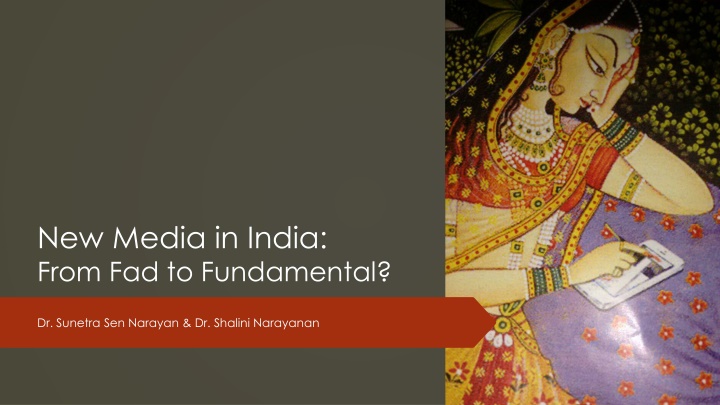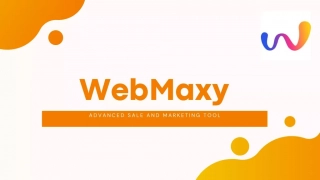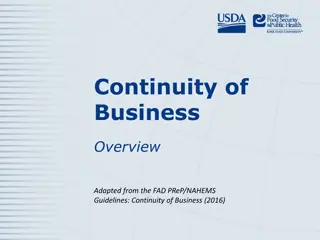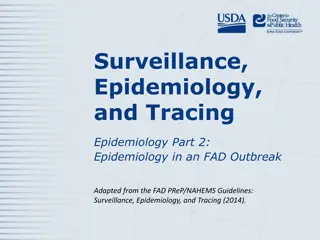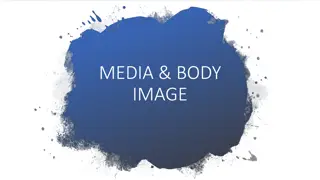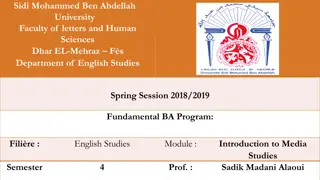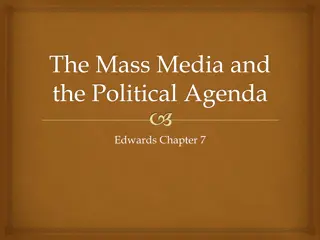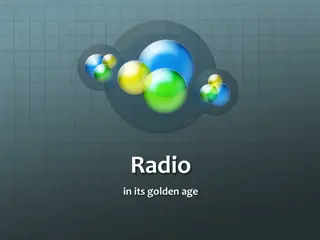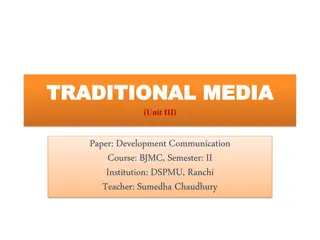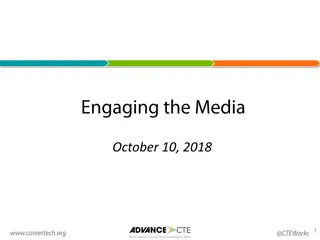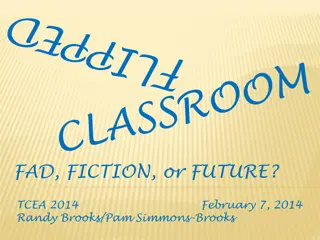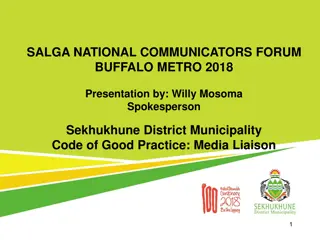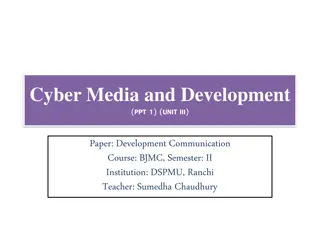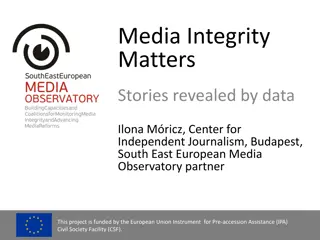New Media in India: From Fad to Fundamental
Exploring the significance of new media in India, this presentation by Dr. Sunetra Sen Narayan and Dr. Shalini Narayanan delves into the evolution and impact of new media on the global stage. With insightful data and analyses, the session addresses key issues and lessons for India and beyond, drawing from their book "India Connected: Mapping the Impact of New Media." From the rise of social media to the vast media landscape, this discussion paints a comprehensive picture of new media's role in shaping modern India.
Download Presentation

Please find below an Image/Link to download the presentation.
The content on the website is provided AS IS for your information and personal use only. It may not be sold, licensed, or shared on other websites without obtaining consent from the author.If you encounter any issues during the download, it is possible that the publisher has removed the file from their server.
You are allowed to download the files provided on this website for personal or commercial use, subject to the condition that they are used lawfully. All files are the property of their respective owners.
The content on the website is provided AS IS for your information and personal use only. It may not be sold, licensed, or shared on other websites without obtaining consent from the author.
E N D
Presentation Transcript
New Media in India: From Fad to Fundamental? Dr. Sunetra Sen Narayan & Dr. Shalini Narayanan
Why India is important when it comes to New Media (2017) 100 1400 In absolute numbers In percentage 90 1200 80 70 1000 60 800 50 40 600 30 20 400 10 200 0 Percentage of world population Internet penetration as a percentage of population Social media usage as percentage of population 0 Population Internet penetration Social media users USA India USA India Dr. Sunetra Sen Narayan & Dr. Shalini Narayanan 5 October 2017
More phones than toilets in the country More English speakers in India than in the UK More Facebook users in India than in the US Prime Minister Modi is the most followed leader on Facebook with almost 43 million fans, President Trump has 24 million followers. On Twitter, President Trump has almost 40 million followers while Prime Minister Modi has 35 million. Incredible India Indian superstar Rajnikanth sKabali got 34 million views on YouTube while Baahubali 4K received 24 million. Star Wars: The Force Awakens got 22 million views. Dr. Sunetra Sen Narayan & Dr. Shalini Narayanan 5 October 2017
The Indian media overview in numbers Permitted private satellite television channels in India (as on Aug 2017): 883; News channels: 388 Doordarshan channels: 34 Private Radio stations in India (as on May 2017): 245 All India Radio stations: 250 Community Radio Stations: 200 Newspapers/ Periodicals in India: 110,000 approx. Dr. Sunetra Sen Narayan & Dr. Shalini Narayanan 5 October 2017
Todays session Aims to situate the growth of new media in India on the world stage, studying its current and projected growth We will also talk about the theoretical underpinnings of new media and how it impacts us in India We then take you through some issues that are of concern, not only for India but for countries across the world We conclude with our thoughts on the phenomenon of new media in India and the lessons that it holds for other countries. This presentation is largely based on our co-edited bookIndia Connected: Mapping the Impact of New Media(Sage, 2016). Other sources include Reports by WeAreSocial, industry bodies in India and NASSCOM, a not-for-profit industry body. The presentation will conclude 15 minutes before the scheduled time to allow for questions Dr. Sunetra Sen Narayan & Dr. Shalini Narayanan 5 October 2017
New Media & the world As of August, 2017, more than half the world has access to the internet. Not all of those who can access the internet, use social media; roughly 80 percent of those who have internet access are on social media. Of those who are using social media, about 92% are accessing it through the mobile. More than three-quarters of mobiles in the world run on the Android platform, the iOS accounts for about 20%. The share of digital users in the developed economies is declining, compared to that in the Asia Pacific region, which is increasing. APAC has more than half the world s digital users and accounted for 70% of the total growth in global internet users in 2016, the most growth coming from South and South-east Asia. Dr. Sunetra Sen Narayan & Dr. Shalini Narayanan 5 October 2017
India Trends In the years between 2000 and 2015, growth rate of internet use went up by nearly 7000% in India! As of July, 2017, India has become the number one country for Facebook users with 241 million people on the platform. The US has 240 million users. However, less than a quarter of FB users in India are female. In contrast, more than half the users in the US are women. The missed call phenomenon is still common in India The most popular pre-paid recharge in India is for Rs.10 (around 15 cents) In the coming years, internet users in India are likely to be more rural, more female, older and more vernacular. By 2021, internet language users are likely to reach 536 million, as compared to English users at 199 million. Dr. Sunetra Sen Narayan & Dr. Shalini Narayanan 5 October 2017
Source: Nasscoms report on The Future of the Internet in India (2016)
Source: Nasscoms report on The Future of the Internet in India (2016)
Dr. Sunetra Sen Narayan & Dr. Shalini Narayanan 5 October 2017
How New Media impacts Society New and particularly social media media have given fresh impetus to the idea and the study of communities with on-line and off-line communities increasingly being connected to each other; New media has the potential to re-vitalise the public sphere, or to provide a virtual public sphere. In utopian terms, new media can be thought of as integrative, empowering, democratizating, breaking bonds of class and stereotypes of gender; In dystopian terms, one can think of it as an instrument of the digital divide, causing hate or violence, promoting pornography, or invading privacy, facilitating criminal activities such as cyber fraud and identity theft.
Theories related to New Media Social media have led to increased importance of active audience theories such as Uses and Gratifications theories (Blumler & Katz,1974) Global village enunciated by Marshall McLuhan, as early as the 1960 s can be applied to digital media; Diffusion of Innovations concept of Everett Rogers, (1983) has helped us to understand factors favoring or inhibiting adoption of mobiles, Internet etc; Information Society (Schement & Curtis, 1995) which has been proposed as a successor to the industrial society or the post-industrial society debates; Castell s (2005) network of networks includes the interaction between communications technologies as well social organizations. Dr. Sunetra Sen Narayan & Dr. Shalini Narayanan 5 October 2017
Theories Related to New Media Globalization: Transformation in the spatial organization of social relations and transactions generating transcontinental flows and networks of activity, interaction and the exercise of power. (Held, 1999) One view which is pertinent to India is that new media is a disruptive force (Jeffrey and Doron, 2013); Postmodern theories would argue that one cannot have a grand theory or dominant world view, as the local level of analysis has risen in importance. Lievrouw and Livingstone (2002) say technology influences and is influenced by society. This is a bi-directional dynamic interaction. For e.g. the regulatory environment in a country, disposable income for new media devices, cultural utility of media Dr. Sunetra Sen Narayan & Dr. Shalini Narayanan 5 October 2017
Factors for high growth rate in telecom sector in India Supply side Liberalisation of the economy post 1990 Liberalization of the telecom sector Supportive policy and regulatory environment Infrastructure, e.g. the Bharatnet Availability of cheap devices Some of the lowest call costs in the world Rapid growth of the Information Technology sector Dr. Sunetra Sen Narayan & Dr. Shalini Narayanan 5 October 2017
Factors for high growth rate in telecom sector in India Demand Side Browsing Email Chatting E-commerce E-services Vernacular content Ultra low cost of handsets Ease of using the phone Dr. Sunetra Sen Narayan & Dr. Shalini Narayanan 5 October 2017
Can lower barriers to entry to the political process to groups who do not hold power - especially with emphasis on user-generated content. New media has also blurred the lines of entertainment and non-entertainment media when it comes to providing political information to the general public. New Media s impact on Politics Personalization, with more direct engagement is the changing focus of political parties and candidates As he took the oath of office as India s Prime Minister after the 2014 general elections, Mr. Narendra Modi had more than 16 million Facebook likes (second most for any politician in the world) Dr. Sunetra Sen Narayan & Dr. Shalini Narayanan 5 October 2017
Impact on Politics: Democratisation of the public sphere Studies show that new media may be making the public sphere more democratic by increasing participation from citizens Lack of access to new media not only hampers participation but also exacerbates the gap by providing advantage to those with access over those without. The gate keeping & agenda setting functions of media houses are becoming less influential. Further diffusion of new media among Indian population may create scope for more voices and increased levels of public participation in the public sphere facilitated by the new media. Dr. Sunetra Sen Narayan & Dr. Shalini Narayanan 5 October 2017
Using social media gives a feeling of empowerment to individuals leading to active participation in political movements in a collective manner. Online activity has the potential to increase offline political participation as well. Resource mobilization theory uses the social, historical, and political contexts of collective action, as well as on the utility and interplay of available resources to explain increased participation in social movements due to online activities. Impact on Political participation and Social Movements Social information processing theory also explains how people use information received through online interactions in a more or less similar manner as they tend to do during face-to-face conversations. Dr. Sunetra Sen Narayan & Dr. Shalini Narayanan 5 October 2017
Censorship, manipulation of user data, the digital divide could undermine the role new media in social movements. Social media use may not be enough as the singular factor to achieve a desired political goal or to change voting intentions of individuals Impact on Political participation and Social movements The use of the Internet and social media has the potential to promote diversification and democratic culture even in authoritarian regimes Dr. Sunetra Sen Narayan & Dr. Shalini Narayanan 5 October 2017
Governance is the process by which governments execute their responsibilities while acknowledging and including the role of other stakeholders in the society which include private firms, non-state actors and citizens Studies have shown that the better a country s e-Government Development Index, EGDI rank, the healthier the country s rank in the corruption perception index. Impact on Governance Governance can be made more effective by improving government processes (through e-Administration), connecting citizens (through e-Services), and building external interactions (through e-Society). Digital India one such initiative. Dr. Sunetra Sen Narayan & Dr. Shalini Narayanan 5 October 2017
Impact on Governance in India The National e-Governance Plan, NeGP is to make all Government services accessible to the common man in his locality, through common service delivery outlets and ensure efficiency, transparency & reliability of such services at affordable costs to realize the basic needs of the common man Gyandoot in Madhya Pradesh was one of the earliest e-Gov initiatives in 2000. Bhoomi, a land records project was another success in Karnataka. E-Samadhan, a grievance redressal and citizen demand service in Himachal has brought transparency and speedy grievance redressal in the state. PAHAL (DBTL) scheme for cooking gas resulted in recurring savings of Rs 30 billion a year with de- duplication after KYC norms was implemented, eliminating 6.3 million ghost connections. Dr. Sunetra Sen Narayan & Dr. Shalini Narayanan 5 October 2017
Regulation of New Media Overall the media sector grew at 9.1% in 2016. India has 857 television channels, over 500 radio stations (public and private), over 110,000 newspapers and periodicals etc. OTT VoD such as Netflix, Amazon Prime also made an entry in 2016. The convergence of telecommunications and new media technologies is a process that is seen to render established modes of regulation redundant (Mattelart, 1994). In India, there is doubt as to whether to have a meta-regulator to deal with these converged platforms or whether to strengthen the existing regulatory bodies that separately govern the print, radio, television and the Internet (Paneerselvam, 2014). Both the Press Council of India and the Parliamentary Committee on IT have suggested a single regulatory body for print and electronic media. Dr. Sunetra Sen Narayan & Dr. Shalini Narayanan 5 October 2017
Regulation of New Media in India Rules/ regulations regarding media in India The Indian Telegraph Act, 1885 which was amended in 1961 and 2004 to broaden the definition of telegraph the Wireless Telegraphy Act, 1933 The Cable Television Networks (Regulation) Act, 1995 The Telecom Regulatory Authority of India Act, 1997 The Information Technology Act, 2000 and the Intermediary Guidelines, 2011 Dr. Sunetra Sen Narayan & Dr. Shalini Narayanan 5 October 2017
Regulation of New Media in India Regulation of new media involves the reconciliation of the rights of an individual vis- -vis society. India sent in the most number of requests to Facebook to restrict content in 2014 (Bhargava, 2015) An important aspect of the right to privacy is the right against unlawful interception of calls and messages and data sharing. The Right to Privacy Bill is pending since 2011. However, the Supreme Court of India has held privacy a fundamental right in the recent case while deciding on linking Aadhar or the Unique Identification number with government schemes. Dr. Sunetra Sen Narayan & Dr. Shalini Narayanan 5 October 2017
The Digital Divide The Digital divide is the disparities in the dissemination of information and access to the knowledge resources between the rich and the poor, rural and urban, computer literates and computer illiterates, etc. It is not a constant. The digital divide not only restricts participation in public discourse, but influences people s access to essential information and services such as online services by the government and others, e.g. registration of deaths/births and online banking Dr. Sunetra Sen Narayan & Dr. Shalini Narayanan 5 October 2017
The Digital Divide Two approaches to informational inequality the internet as a public good, which the state must endeavor to provide to its citizens. The political economy approach urges the state to provide affordable internet access to all its citizens. The digital divide exists not only in terms of access but in maximizing the effectiveness of the technology. Government initiatives include the Bharatnet or National Optical Fibre Newtwork, NOFN project to link 0.25 million panchayats by the Fibre Optic network. The project is running much behind schedule with only .08 million villages connected till June, 2017. The National Rural Internet & Technology Mission as well asthe Smart Cities project are other initiatives. Dr. Sunetra Sen Narayan & Dr. Shalini Narayanan 5 October 2017
The Digital Divide - Gender Access and Abuse -- the two major barriers to women s more effective engagement with online media. If a family has to choose between giving access to the internet to a boy or girl, it is inevitably the boy who gets it. In Feb 2016, Suraj village in Mehsana district of Gujarat banned women from using the mobile phone. In 2014, a khap panchayat banned women in 46 villages of Muzaffarpur district from using the mobile. Moral corruption and increase in crimes against women was given as cause. According to reports, only 24% of Facebook users are women. The harassment and abuse faced by women users of the Internet can lead to another kind of marginalization. Just as women have had to constantly battle to preserve and protect their right to public space, they have had to constantly assert their rights to online space. Well-known women celebrities like Tamil playback singer Chinmayi Sripada, Dalit writer Meena Kandaswamy, and television anchor Sagarika Ghose have all been subjected to cyber abuse. The Rana Ayyub case, Gurmehar being trolled and so many examples. However, abuse or trolling is not limited to women. Dr. Sunetra Sen Narayan & Dr. Shalini Narayanan 5 October 2017
The problem of fake news The phenomenon is widespread on new media in India; enough for Facebook to launch an offline campaign to encourage people to be more discerning in what they share. Full-page adverts were published on 21st Sept 2017 in national dailies Fake news leading to mass hysteria, rumour-mongering resulting in clashes and even deaths in some cases. Misappropriation of images to incite communal passions rampant, leading to, in one case, a mass exodus. Government s response is generally to shut down internet services and try to take down incendiary content. Media literacy poor in India, especially regarding new media. Dr. Sunetra Sen Narayan & Dr. Shalini Narayanan 5 October 2017
Impact on Marketing: the rise of e-commerce China the behemoth accounts for over half the e- commerce market globally, followed by the US; India remains early stage E-commerce in India valued at $14 billion and growing at a CAGR of 30%; Amazon India, Flipkart, IRCTC among biggest companies By 2020, e-commerce is likely to touch $34 billion, with over 200 million people transacting online; by 2030 likely to reach $200 billion Factors driving growth include growing internet and mobile penetration, rise of digital payments, security, access to funding, entry of global majors, innovations in mobile technology etc Moving from eCommerce 1.0 model focused on price to eCommerce 2.0 focused on high quality, intuitive, curated and personalized, omni-channel user experience Future trends indicate likely to move towards hyper-local on- demand market Dr. Sunetra Sen Narayan & Dr. Shalini Narayanan 5 October 2017
Conclusion Digital is changing the way we interact; Glocalization and hybridity is what is happening in the Indian context with overlapping frames of tradition and modernity; Future for new media in India is more vernacular, more women, older demographic profile and more rural; The role of community has been redefined in this era; disruption of hierarchies are suggested by some scholars; Optimists may talk about the emancipating potential or democratizing influence of social media; Pessimists talk about the consumer society, the surveillance state, the electronic Leviathan or repression and invasion of privacy, along with fake news and trolling- the two new bugbears; Both aspects can co-exist and future evolution of social media depends on the context in which it is used. Dr. Sunetra Sen Narayan & Dr. Shalini Narayanan 5 October 2017
Thank you for your attention Any questions? Dr. Sunetra Sen Narayan & Dr. Shalini Narayanan 5 October 2017
